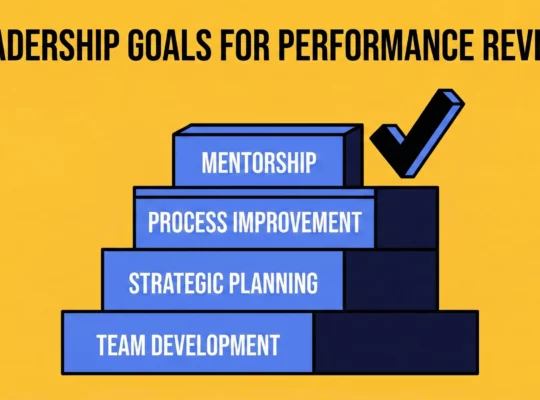Talent acquisition recruitment goals are critical in shaping a successful hiring strategy. Setting clear and measurable goals for HR professionals and recruiters helps align talent acquisition with broader business objectives. Review.jobs is committed to helping you achieve these goals with strategies tailored tools and expert advice. Whether you’re focused on speeding up the hiring process or enhancing your employer brand, establishing well-defined recruitment goals will guide your efforts and ensure you attract the top talent your company needs.
- Overview of Talent Acquisition
- The Role of Recruitment Goals
- Understanding Recruitment Goals
- Key Talent Acquisition Recruitment Goals
- How to Set SMART Recruitment Goals
- Aligning Recruitment Goals with Business Objectives
- Continuous Improvement and Adaptation
- FAQs
I. Overview of Talent Acquisition
Talent acquisition is more than just filling job vacancies; it’s about strategically identifying, attracting, and retaining talent that aligns with your company’s long-term goals. In a rapidly evolving job market, talent acquisition has become a critical function, directly impacting a company’s success. The process involves identifying potential candidates, evaluating their fit with the company culture, and ensuring they can contribute to the company’s future. Achieving these outcomes requires setting clear recruitment goals, which serve as the foundation for a robust talent acquisition strategy.
II. The Role of Recruitment Goals
Setting recruitment goals is essential for ensuring that your talent acquisition efforts are aligned with the broader business objectives. Clear recruitment goals provide direction and focus, enabling your team to prioritize tasks, measure progress, and make data-driven decisions. These goals also help in establishing a clear vision of what success looks like, whether it’s reducing time-to-hire, improving candidate quality, or enhancing the overall candidate experience.
III. Understanding Recruitment Goals
Definition and Importance
Recruitment goals are specific, measurable objectives that guide the talent acquisition process. These goals are critical because they help organizations stay focused on key outcomes, such as hiring top talent, improving time-to-hire, and reducing recruitment costs. By setting clear recruitment goals, companies can ensure that their talent acquisition efforts are effective, efficient, and aligned with their overall business strategy.
Types of Recruitment Goals
Recruitment goals can be broadly categorized into two types: talent-focused and operational. Talent-focused goals are aimed at attracting, hiring, and retaining the right talent. These goals often revolve around improving the quality of hires, enhancing employer branding, and diversifying the candidate pool. Operational goals, on the other hand, are related to the efficiency of the recruitment process. These may include reducing time-to-hire, lowering cost-per-hire, and optimizing the recruitment workflow. Both types of goals are essential for a successful talent acquisition strategy.
IV. Key Talent Acquisition Recruitment Goals
Speed Up the Hiring Process
A prolonged hiring process can result in losing top talent to competitors, which is why 23% of recruitment professionals consider reducing time-to-hire as a top priority when it comes to talent acquisition.
To reduce time-to-hire, companies can leverage technology such as applicant tracking systems (ATS) and AI-driven recruitment tools. Streamlining the hiring process through automation and clear communication can significantly reduce delays, allowing your team to secure top candidates faster.
Enhance Employer Branding
A strong employer brand is crucial in attracting top talent. Enhancing your employer branding should be a key recruitment goal. A strong employer brand not only attracts potential candidates but also improves employee retention. Employer branding in recruitment includes showcasing company culture on social media, providing an exceptional candidate experience, and collecting positive employee reviews on platforms like Review.jobs.
Improve Quality of Hire
The quality of hire is a vital metric that reflects the effectiveness of your recruitment process. Improving this metric should be a primary goal in your talent acquisition strategy. Focus on attracting high-quality candidates through skills-based hiring, detailed job descriptions, and a thorough candidate assessment process. By refining these elements, you can increase the likelihood of hiring employees who contribute significantly to the company’s success.
Diversify the Candidate Pipeline
Diversity and inclusion should be at the forefront of your recruitment goals. In fact, 77% of talent professionals anticipate that diversity will play a crucial role in future recruitment efforts. A diverse candidate pipeline ensures a variety of perspectives and ideas within your organization, leading to innovation and growth.
Strategies to diversify the candidate pipeline include using inclusive job descriptions, partnering with organizations that support diversity, and leveraging social media to reach a broader audience.
Reduce Cost Per Hire
Reducing cost per hire without compromising quality is a challenge that many companies face. By implementing cost-effective recruitment strategies such as referral programs, optimizing job postings, and utilizing data-driven recruitment marketing, companies can lower recruitment costs. Additionally, streamlining the hiring process and reducing time-to-hire can also contribute to cost savings.
V. How to Set SMART Recruitment Goals
Specific
Setting specific recruitment goals is crucial for achieving measurable results. For example, instead of setting a goal to “hire faster,” set a goal to “reduce time-to-hire by 20% in Q1 2025.” This clarity provides your team with a concrete target to aim for, making it easier to focus efforts and resources.
Measurable
Measuring the success of your recruitment goals is essential to track progress and make informed decisions. Key performance indicators (KPIs) such as time-to-hire, cost-per-hire, and candidate experience scores can help you assess whether you are on track to meet your goals. Regularly reviewing these metrics ensures that you can adjust your strategy as needed.
Achievable
Recruitment goals should be realistic and achievable, given the resources and constraints of your organization. Setting unattainable goals can lead to frustration and burnout. Instead, base your goals on data, such as historical hiring data or industry benchmarks, to ensure they are within reach.
Relevant
Your recruitment goals should align with the company’s overall strategic direction. For example, if your company is focusing on expanding into new markets, your recruitment goals might include attracting talent with specific language skills or experience in those regions. Ensuring relevance keeps your recruitment efforts aligned with broader business objectives.
Time-Bound
Setting deadlines for your recruitment goals is crucial for maintaining momentum and focus. For instance, if your goal is to “increase the quality of hire,” set a timeframe such as “by the end of Q2 2024.” Time-bound goals help create a sense of urgency and accountability within the recruitment team.
VI. Aligning Recruitment Goals with Business Objectives
Integration with Business Strategy
Aligning recruitment goals with business objectives ensures that your talent acquisition efforts support the company’s strategic direction. For instance, if your business strategy involves innovation, your recruitment goals might focus on attracting candidates with a strong background in research and development.
By integrating recruitment goals with business strategy and enforcing strategic recruitment branding, you can ensure a cohesive and targeted approach to hiring.
Involvement of Stakeholders
Involving key stakeholders in the recruitment goal-setting process is essential for gaining buy-in and ensuring alignment. Stakeholders, such as department heads and senior executives, can provide valuable insights into the skills and attributes needed for specific roles. Their involvement ensures that recruitment goals are aligned with the company’s broader objectives and that there is support for the necessary resources and initiatives.
VII. Continuous Improvement and Adaptation
Regular Review and Adjustment
Recruitment goals should not be static. Regularly reviewing and adjusting your goals is essential for staying responsive to changing market conditions and business needs.
For example, if your company’s growth trajectory changes, you may need to adjust your hiring goals to accommodate increased demand for talent. Continuous improvement ensures that your recruitment strategy remains effective and relevant.
Collect Employee Insights
Feedback from current employees can provide valuable insights into the candidate experience and help refine your recruitment goals. Platforms like Review.jobs offer a trusted space for employees to share their experiences, which can then be used to improve the recruitment process.
By incorporating employee insights, you can create a more enjoyable experience for future candidates and ensure that your recruitment goals align with the expectations of your workforce.
Celebrate Successes
Recognizing and rewarding achievements is crucial for maintaining motivation and engagement within your recruitment team. Celebrating successes, whether it’s meeting a specific recruitment goal or achieving a milestone in the hiring process, helps to reinforce the importance of these goals and keeps the team focused on continuous improvement.
Final Thoughts
Setting effective talent acquisition recruitment goals is essential for ensuring that your company attracts and retains top talent. By aligning these goals with broader business objectives, using SMART criteria, and continuously reviewing and adapting your strategy, you can create a robust and responsive recruitment process. Review.jobs is here to support you in achieving these goals, providing the tools and insights needed to succeed in the evolving talent landscape. Start setting your recruitment goals today to ensure a successful talent acquisition strategy for the future.
FAQs
1. What are talent acquisition recruitment goals?
Talent acquisition recruitment goals are specific objectives that guide the hiring process within an organization. These goals help ensure that recruitment efforts are aligned with the company’s broader business strategy, such as reducing time-to-hire, improving the quality of hires, and enhancing employer branding.
2. Why are recruitment goals important?
Recruitment goals are important because they provide direction and focus for your talent acquisition strategy. By setting clear goals, you can measure progress, make data-driven decisions, and ensure that your recruitment efforts are effective and efficient. They also help in aligning the recruitment process with overall business objectives.
3. What are some examples of recruitment goals?
Examples of recruitment goals include:
- Speeding up the hiring process to reduce time-to-hire.
- Enhancing employer branding to attract top talent.
- Improving the quality of hires through better assessment and selection methods.
- Diversifying the candidate pipeline to ensure a more inclusive recruitment process.
- Reducing cost-per-hire without compromising the quality of candidates.
4. How can I set SMART recruitment goals?
SMART recruitment goals are Specific, Measurable, Achievable, Relevant, and Time-Bound. For example, instead of a general goal to “hire faster,” a SMART goal would be to “reduce time-to-hire by 20% in Q1 2025.” This approach ensures that your goals are clear, trackable, realistic, aligned with your company’s strategy, and have a set deadline.
5. How do recruitment goals align with business objectives?
Recruitment goals align with business objectives by ensuring that the talent acquisition strategy supports the company’s overall goals. For example, if your company is expanding into new markets, your recruitment goals might focus on attracting candidates with specific skills or experience in those areas. This alignment helps create a cohesive approach to achieving business success.
6. How often should recruitment goals be reviewed and adjusted?
Recruitment goals should be reviewed and adjusted regularly to ensure they remain relevant and effective. Regular reviews allow you to respond to changes in the job market, business needs, and the success of current strategies. Continuous improvement is key to maintaining a successful talent acquisition process.
7. How can employee insights improve recruitment goals?
Employee insights can provide valuable feedback on the candidate experience, helping to refine and improve the recruitment process. Collecting feedback through platforms like Review.jobs allows you to understand what works well and where improvements are needed, ensuring that your recruitment goals align with the expectations and experiences of your workforce.





